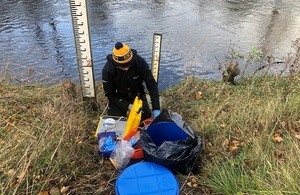Global S&T Development Trend Analysis Platform of Resources and Environment
| Pilot project aims to help safeguard native white-clawed crayfish | |
| admin | |
| 2021-12-16 | |
| 发布年 | 2021 |
| 语种 | 英语 |
| 国家 | 英国 |
| 领域 | 资源环境 |
| 正文(英文) |
Press release
Pilot project aims to help safeguard native white-clawed crayfishSurvey work has started as part of a new Environment Agency pilot to trace native and non-native crayfish in North East and Yorkshire rivers. 
Images shows Ian Marshall from the EA using the new surveying equipment The £20,000 National Crayfish Monitoring Programme includes environmental DNA (eDNA) surveying that will focus on identifying the presence of native white-clawed crayfish, invasive signal crayfish and crayfish plague. Surveys took place in November across Northumberland, North and West Yorkshire, including the River Ure near Bainbridge and a Stillwater near Holmfirth. The signal crayfish, which originates from America, is bigger, more aggressive and out-competes the native white clawed crayfish. They also carry a fungal disease known as crayfish plague, which is fatal to the native species. Some areas of the North East and Yorkshire have some native crayfish populations in their rivers, some of the last strongholds in the country. Endangered native crayfishIan Marshall, Biodiversity Technical Specialist in the North East and white-clawed crayfish National Species Lead for the Environment Agency, is leading on the work. He said:
New method of surveyingThe new method was successfully implemented by the Marine Institute Ireland (MII) and involves pumping a large amount of river water through a glass fibre filter using a specialist pump. This is then sent to MII and the Environment Agency’s National Laboratory Service for analysis. It’s hoped the new survey methods will better support white-clawed crayfish conservation efforts. The £20,000 project is funded jointly by the Environment Agency and Defra. Ian is also exploring how to apply the new method to other protected species, such as freshwater pearl mussels, as well as to invasive species. He added:
River users can play a vital role in conserving the future of white clawed crayfish. The Environment Agency urges people to ‘Check – Clean – Dry’ their footwear and equipment after spending time in and around watercourses. Anything that has contact with the water and riverbank needs to be cleaned thoroughly and dried until it has been dry for 48 hours. If this is not possible, cleaning and the use of an environmentally friendly aquatic disinfectant is recommended. This will make sure all aquatic diseases and invasive species are killed. More information can be found on the Invasive non-native species website.
Published 16 December 2021
|
| URL | 查看原文 |
| 来源平台 | UK Environment Agency |
| 文献类型 | 新闻 |
| 条目标识符 | http://119.78.100.173/C666/handle/2XK7JSWQ/343650 |
| 专题 | 资源环境科学 |
| 推荐引用方式 GB/T 7714 | admin. Pilot project aims to help safeguard native white-clawed crayfish. 2021. |
| 条目包含的文件 | 条目无相关文件。 | |||||
| 个性服务 |
| 推荐该条目 |
| 保存到收藏夹 |
| 查看访问统计 |
| 导出为Endnote文件 |
| 谷歌学术 |
| 谷歌学术中相似的文章 |
| [admin]的文章 |
| 百度学术 |
| 百度学术中相似的文章 |
| [admin]的文章 |
| 必应学术 |
| 必应学术中相似的文章 |
| [admin]的文章 |
| 相关权益政策 |
| 暂无数据 |
| 收藏/分享 |
除非特别说明,本系统中所有内容都受版权保护,并保留所有权利。
修改评论